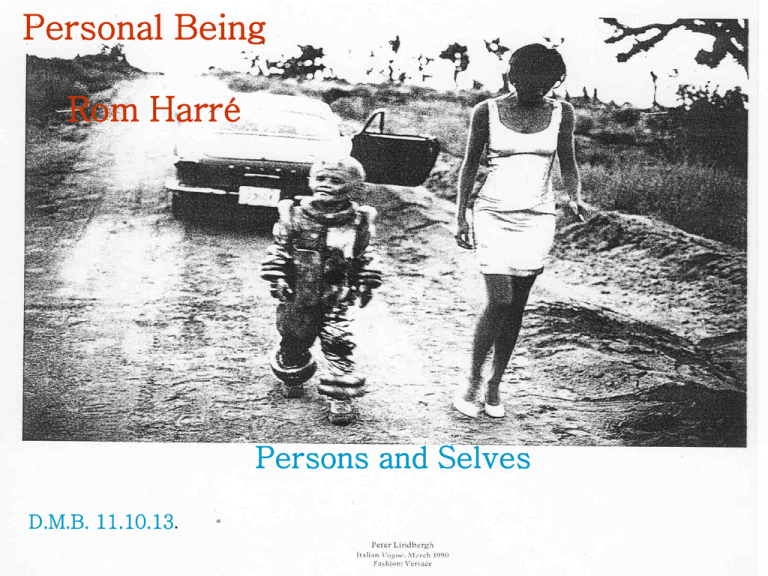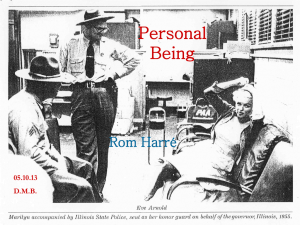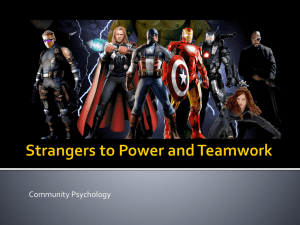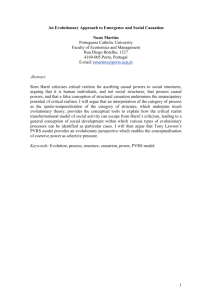PowerPoint
advertisement

Personal Being Rom Harré Persons and Selves D.M.B. 11.10.13. Persons and Selves Rom Harré offers a particular methodology to understand the nature of personal being, and it is one particularly suited to a study of the nature of isolation and solitude. As before, the quoted sections given below, and the diagrams, come directly from his book and may be used in your assignment. Remember also that at the core of this theory are three unities: identity, consciousness, and agency. In terms of the assignment, this means that whatever else you make of your source text, you will need to analyse it in these terms at least, if in no others! We resume with Harre’s introductory remarks, which are intended to establish informally the distinction between self and person. I have used colour to link quotes with my explanations – I hope this helps. Harré characterises the self in these terms: ‘The central pivot of my argument is this: the semantics of the conceptual cluster around the general notion of the ‘self’ is to be understood as if the ‘self’ were a theoretical concept like those of the natural sciences, judged by its behavioural and material analogies and its degree of co-ordination with the analytic analogue that is in use in abstracting experiential patterns, which are to be explained by invoking it’ (p. 25). Take the concept of gravity as an illustration – we are aware of what it does, we can measure the forces involved, and people were subject to the consequences of gravity long before Isaac Newton produced his theory and named it. In language, we assume a self which co-ordinates experience, and this ‘abstracted experience’ is then explained by referring to the nature of the self that has carried out these observations! Harré continues, ‘Unlike the natural sciences, in the human sciences the productive process, and in particular the beings involved in it, are themselves products of ‘educational’ processes in which these very theoretical concepts play an indispensable part. These beings are what they are partly by virtue of holding this or that theory’ (p. 25). In psychology, sociology, anthropology, etc. the production of new concepts and their inter-relationship with others are all dependent on the definition of the self that exists within the society that is sustaining these kinds of research. But as these sciences become embedded in the culture of that society, so the concepts begin to influence the ‘making’ of individuals – think of Piagettian babies, or Vygotskyian babies, etc! So where does the ‘theoretical’ notion of the self come from in the first place? Harre suggests: ‘[It is] my belief that the central constructing concept of the individual human psychology is a concept of ‘self’, but that it is a theoretical concept whose source analogue is the socially defined and sustained concept of ‘person’ that is favoured in the society under study and is embodied in the grammatical forms of public speech appropriate to talk about persons. Our personal being is created by our coming to believe a theory of self based on our society’s working conception of a person. I can change my personal being only if I can come to believe a theory of self derived from the concept of a person current in another and different society’ (p. 26; my parentheses). (For ‘Westerners’ these narratives may be helpful to consider: Shogun, The Marsh Arabs, and The Jewel in the Crown.) This gives a definition for the entire project: ‘By ‘person’ I intend the socially defined, publicly visible embodied being, endowed with all kinds of powers and capacities for public, meaningful action, … . By ‘self’ I mean the personal unity I take myself to be, my singular inner being, so to speak.’ … (p. 26; my ellipses). Harré stresses that this sense of self is different from the ‘self-concept’ – a term used in psychology to indicate the bundle of beliefs that an individual may hold about themselves, i.e., I’m honest, likeable, and hard-working, etc. Harré’s self is much more deeply embedded in our sense of identity as a ‘me’ or an ‘I’, in our sense of agency as ‘my actions’, ‘my thoughts’, and the sense that this these thoughts are ‘my’ thoughts. Personal Identity: ‘I distinguish the socially defined fact of personal identity, in which the particularity of personal embodiment plays a central part, from the personal sense of identity through which a person conceives of him or herself as a singular being with a continuous and unique history. The latter is a necessary condition for the acquisition of a theory of the self, which is experienced as the sense of identity.’ (p. 27). Self-consciousness: ‘As a form of knowledge, consciousness must take on the structure of the grammatical forms in which personal knowledge is expressed in psycho-linguistically distinct cultures. I argue for a distinction between consciousness as the experiencing of something and consciousness as knowing that one is experiencing something.’ (p. 27). Harré adds that, ‘the experiential aspect of consciousness can be expressed by using the concepts of ‘awareness’ and ‘attention’.’ (p. 27). Agency: ‘To be an agent is to be something more than a creature with a sub-personal psychology formed of active components like drives, motivations, intentions and desires. To be an agent is to conceive of oneself as (hold a theory that one is) a being in possession of an ultimate power of decision and action. A pure agent is capable of deciding between alternatives, even if they are equally attractive or forceful. A pure agent is capable of over-coming temptations and distractions to realize its plans. It can adopt new principles and it can curb its own desires.’ (p. 29). Agency, cont. ‘I believe that what is transcendental to experience is none other than the social conditions under which persons are created from mere organic beings by their acquiring a theory appropriate to their society. To be self-conscious and to act freely are not, I believe, mysterious capacities, but particular ways of thinking about what one is experiencing, planning, executing and so on.’ (p. 29). For Harré, then, proof that agency, identity, and consciousness exist ‘above’ sub-personal desires, intentions, etc. depends on taking akrasia (weakness of the will) seriously, along with bloody-mindedness. These represent the two poles of the self’s unified autonomy. His second chapter is devoted to the analysis of the dimensions of application and the root components underpinning the concept of autonomous being, and by way of a reminder, recall that in week 1, I indicated that Harré dispenses with the commonly used ‘Cartesian’ distinctions between mental and material actions, between subjective v. objective facts, or ‘inner’ and ‘outer’ experiences. ‘A field of application can be presented as a space. Taking the metaphor a step further, I shall call the critical study of fields of application ‘dimensional analysis’ and the teasing out of root ideas … ‘componential analysis’.’ (p. 35). Harré, later in the same chapter, provides this diagram:DISPLAY Public Passive Individual Collective REALIZATION Active See slide 12 for explanation. AGENCY Private (Figure 2.1, p. 44.) The three axes constitute, in Harré’s terms, three ‘spaces’ which are independent of one another. The figure indicates that display, realization, and agency are features of human life which can vary independently to one another, and within each dimension according to the distinction between there being one instance and many. For ‘display’, the range is from the private to the public and so one can think of public spectacles and private fantasies, presentations intended for public forms of recognition, and those private acts of display which are only intended for oneself. For ‘realisation’ the range runs from individual to collective, and what is identified is the manner by which an action is realised – through public works or by individual interventions. Finally, there is ‘agency’ itself, but the range here seems to be different in kind, since it runs from activity to passivity. The problem is resolved, however, if ‘passivity’ means obeying orders! Harré makes the point that with such a diagram one can think of it as being like a solid square block that has been cut in half horizontally, vertically, and through its depth resulting in eight smaller square blocks or quadrants. He continues, ‘Each of the eight cells offers possibilities for the use of psychological concepts. The location ‘private – collective – active’ allows for the attribution of quasipsychological concepts to such pseudo-entities as firms. For instance, the concept of ‘information’ could be applied to this location in the three-space. We might speak of concealing information from other firms.’ (p. 44). In terms of of the narratives likely to feature in your first assignment, the act of going into solitude is likely to result in the location ‘private – active – individual’, but it may be preceded by a sense that one’s self was forced to exist as ‘passive – public – collective’. ‘A psychological attribute need not be forever fixed in a particular application. The development of a human being would typically involve a time-dependent displacement of attributes through the three-space. For instance, small children have not learned to keep their intentions to themselves. The concept of ‘intention’ for a two-year old would be located in the region public – individual – active. A year and a half earlier, at the stage of psychological symbiosis, when his mother is formulating his intentions for him, the concept would be located in the region public – collective – passive, the social region.’ (p. 44). He continues with a warning: ‘… I do not want the poles of my dimensions to be taken as distinctions … I am proposing that the dimensions are continua. A psychological concept can be considered as more or less privately displayed. The continuity of the dimensions is mediated by language and other symbolic systems which span the space between the poles.’ (p. 45). Harré now provides a second diagram, and makes the following comment: ‘In the private – public dimension language is understood as a common instrument of representation. In the individual – collective dimension language is understood as a common instrument of action, e.g. ‘I order …’ compared with ‘It is required that …’ (p. 45, Harré’s italics). DISPLAY Public Social 1 Individual 4 Collective REALIZATION 2 3 Personal Private Figure 2.2, p. 45. The last figure illustrates how Harré thinks personal/child development, can be mapped onto a two-space array of person dimensions through changing networks of social interaction. Figure 4.1 (p. 107), N.B. this is adapted for our purposes – shown by text in colour. Individual DISPLAY Public Person 4 1 If the development is from an existing form of personhood, rather than from a new born, then a social equivalent to ‘symbiosis’ is likely. Collective REALIZATION The issue of personal development is also tackled in a related way by Donald Winnicott – PowerPoint to follow. 3 2 Self – position where symbiosis with the mOther begins to Private relax.









